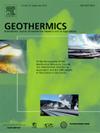An improved modeling method using overlapping meshes for geothermal wellbore simulation
IF 3.9
2区 工程技术
Q3 ENERGY & FUELS
引用次数: 0
Abstract
Since temperature and pressure disturbances in geothermal reservoirs are mainly caused by production and injection activities through wellbores, establishing an accurate wellbore model is crucial. However, due to significant size discrepancies between wellbores and reservoirs, accurately resolving the wellbore geometry requires a large number of mesh cells, which seriously reduces computational efficiency. A commonly used method to reduce the mesh cell number is simplifying the wellbore geometry as a point (in 2D) or a line (in 3D). However, existing modeling methods for this simplified wellbore geometry introduce additional errors. To improve calculation accuracy without reducing computational efficiency, we propose an overlapping mesh modeling method, which incorporates one overlapping cell for each wellbore, enabling the wellbore geometry to be considered without impacting the reservoir mesh generation. The wellbore cell can exchange mass and energy with the reservoir cells it covers, ensuring that the temperature and pressure disturbances caused by wells can be simulated accurately. Four benchmark cases were used to verify the present method. The results show that, compared to existing simplified wellbore modeling methods, the present method reduces hydraulic head errors by 1 to 2 m and temperature errors by 1 to 2 ℃ in the vicinity of the wellbore, while the additional computational cost is negligible.
一种改进的叠合网格地热井筒模拟方法
由于地热储层的温度和压力扰动主要是由井筒内的生产和注入活动引起的,因此建立准确的井筒模型至关重要。然而,由于井眼和油藏之间存在显著的尺寸差异,精确求解井筒几何形状需要大量的网格单元,这严重降低了计算效率。减少网格单元数的一种常用方法是将井筒几何形状简化为一个点(2D)或一条线(3D)。然而,对于这种简化的井筒几何形状,现有的建模方法引入了额外的误差。为了在不降低计算效率的情况下提高计算精度,我们提出了一种重叠网格建模方法,该方法为每个井眼包含一个重叠单元,从而在不影响油藏网格生成的情况下考虑井眼几何形状。井筒单元可以与其覆盖的储层单元交换质量和能量,确保可以准确模拟井引起的温度和压力干扰。用四个基准案例验证了该方法的有效性。结果表明,与现有简化的井筒建模方法相比,该方法可将井筒附近水头误差减小1 ~ 2 m,温度误差减小1 ~ 2℃,而额外的计算成本可以忽略不计。
本文章由计算机程序翻译,如有差异,请以英文原文为准。
求助全文
约1分钟内获得全文
求助全文
来源期刊

Geothermics
工程技术-地球科学综合
CiteScore
7.70
自引率
15.40%
发文量
237
审稿时长
4.5 months
期刊介绍:
Geothermics is an international journal devoted to the research and development of geothermal energy. The International Board of Editors of Geothermics, which comprises specialists in the various aspects of geothermal resources, exploration and development, guarantees the balanced, comprehensive view of scientific and technological developments in this promising energy field.
It promulgates the state of the art and science of geothermal energy, its exploration and exploitation through a regular exchange of information from all parts of the world. The journal publishes articles dealing with the theory, exploration techniques and all aspects of the utilization of geothermal resources. Geothermics serves as the scientific house, or exchange medium, through which the growing community of geothermal specialists can provide and receive information.
 求助内容:
求助内容: 应助结果提醒方式:
应助结果提醒方式:


